It looks like you're using an Ad Blocker.
Please white-list or disable AboveTopSecret.com in your ad-blocking tool.
Thank you.
Some features of ATS will be disabled while you continue to use an ad-blocker.
share:
Sigiriya, or Lion's Rock, in Sri Lanka is one of the most amazing places on earth. I'm quite surprised that it isn't more well known. It is such a
beautiful place with so much history. The artwork featured at Sigiriya is absolutely stunning. The surrounding area is filled with gardens and
reservoirs making this place one of the most spectacular sights on the planet. Please take a moment, and look at some of the links for additional
pictures of Sigiriya, and of the art to be found there, and watch the videos embedded here. You will not be disappointed in the beauty of the
place.
suellewellyn2011.wordpress.com...
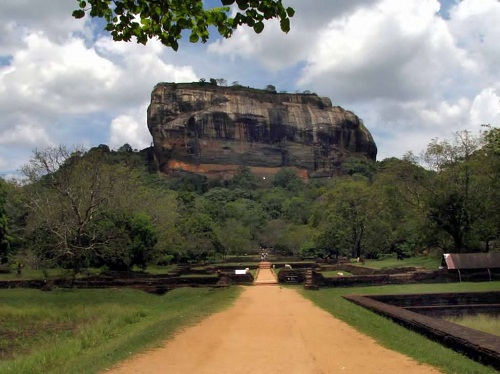
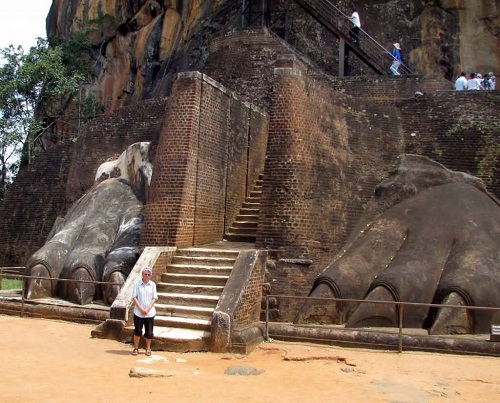
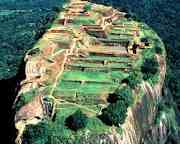
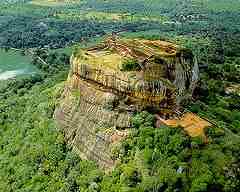
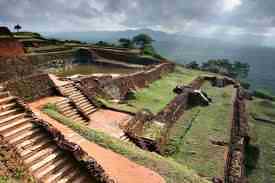
en.wikipedia.org...
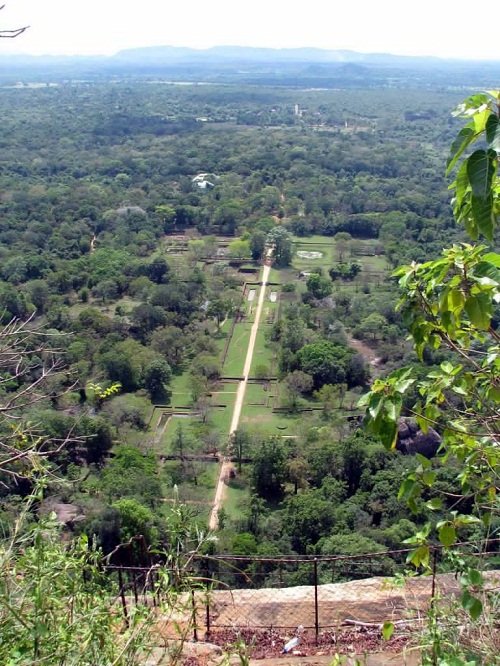
sigiriya.org...
www.travel-images.com...
Sites like Sigiriya are often overlooked because of their location. We need to protect such rare treasures as these, so that future generations may look at them with the same wonder that people do today.
whc.unesco.org...
suellewellyn2011.wordpress.com...

Sigiriya (Lion’s rock) is a large stone ancient rock fortress and palace ruin in the central Matale District of Sri Lanka. It is surrounded by the remains of an extensive network of gardens, reservoirs, and other structures and renowned for its ancient frescos. It is one of the eight World Heritage Sites of Sri Lanka. It is also declared by UNESCO as the 8th Wonder of the World.

Sigiriya may have been inhabited through prehistoric times. It was used as a rock-shelter mountain monastery from about the 5th century BC, with caves prepared and donated by devotees of the Buddhist Sangha. According to the chronicles the entire complex was built by King Kashaypa (AD 477 – 495), and after the king’s death, it was used as a Buddhist monastery until 14th century.
Halfway up the rock, within an inaccessible rocky shelter in the vertical wall of the western face are rock paintings which have brought universal acclaim to the site of Sigiriya – ‘The Maidens of the Clouds’, 21 non-identified female figures, comparable to the most beautiful creations of Ajanta



en.wikipedia.org...
Sigiriya consists of an ancient castle built by King Kashyapa during the 5th century. The Sigiriya site has the remains of an upper palace sited on the flat top of the rock, a mid-level terrace that includes the Lion Gate and the mirror wall with its frescoes, the lower palace that clings to the slopes below the rock, and the moats, walls, and gardens that extend for some hundreds of metres out from the base of the rock.
The site is both a palace and a fortress. Despite its age, the splendour of the palace still furnishes a stunning insight into the ingenuity and creativity of its builders. The upper palace on the top of the rock includes cisterns cut into the rock that still retain water. The moats and walls that surround the lower palace are still exquisitely beautiful.

John Still in 1907 suggested, "The whole face of the hill appears to have been a gigantic picture gallery... the largest picture in the world perhaps".[14] The paintings would have covered most of the western face of the rock, covering an area 140 metres long and 40 metres high. There are references in the graffiti to 500 ladies in these paintings. However, many more are lost forever, having been wiped out when the Palace once more became a monastery − so that they would not disturb meditation.[citation needed] Some more frescoes, different from the popular collection, can be seen elsewhere on the rock surface, for example on the surface of the location called the "Cobra Hood Cave".
Although the frescoes are classified as in the Anuradhapura period, the painting style is considered unique;[citation needed] the line and style of application of the paintings differing from Anuradhapura paintings. The lines are painted in a form which enhances the sense of volume of the figures. The paint has been applied in sweeping strokes, using more pressure on one side, giving the effect of a deeper colour tone towards the edge. Other paintings of the Anuradhapura period contain similar approaches to painting, but do not have the sketchy lines of the Sigiriya style, having a distinct artists' boundary line. The true identity of the ladies in these paintings still have not been confirmed. There are various ideas about their identity. Some believe that they are the wives of the king while some think that they are women taking part in religious observances. These pictures have a close resemblance to some of the paintings seen in the ajanta caves in India
The frescoes, depicting beautiful female figures in graceful contour or colour, point to the direction of the Kandy temple, sacred to the Sinhalese.
sigiriya.org...
www.travel-images.com...
Sites like Sigiriya are often overlooked because of their location. We need to protect such rare treasures as these, so that future generations may look at them with the same wonder that people do today.
whc.unesco.org...
edit on 7-2-2012 by isyeye because: (no reason given)
I have a friend who is from Sri Lanka and he did a class presentation on this ! Just mind blowing! how come the rest of the world never talks about
this stupendous site?? I would love to visit it ,and I'm afraid of heights!
reply to post by MrsBlonde
I'm wondering the same thing. I'm totally blown away by the beauty of this place. If it wasn't on the other side of the world, I'd be on my way to visit right now.
Just mind blowing! how come the rest of the world never talks about this stupendous site??
I'm wondering the same thing. I'm totally blown away by the beauty of this place. If it wasn't on the other side of the world, I'd be on my way to visit right now.
Now that sure is a sight to spark the imagination. I can't help but think of what went into making it.... Thanks! I have another stop to add on my
bucket list of places to visit!
reply to post by isyeye
I can see quite clearly why it's the 8th wonder of the world...positively marvelous.
And just think, this was crafted WITHOUT our technology, and it's still standing! Kinda makes you wonder if all of our gas-chugging super-advanced science projects are really needed...I mean, if they could do it wither their simple tools...why not us?
Wonderful thread. s&f
I can see quite clearly why it's the 8th wonder of the world...positively marvelous.
And just think, this was crafted WITHOUT our technology, and it's still standing! Kinda makes you wonder if all of our gas-chugging super-advanced science projects are really needed...I mean, if they could do it wither their simple tools...why not us?
Wonderful thread. s&f
reply to post by isyeye
S+F- beautiful! I am not, by principle, one of those people who says "this is the sort of stuff I come to ATS for," but if I was going to say it about any thread, it would be this one!!! A new, fascinating, ancient site that I had never heard about before, but I am VERY glad to have been introduced to it! I will be definitely looking up more about this beautiful Lion's Rock!
Thank you,
Seraph
S+F- beautiful! I am not, by principle, one of those people who says "this is the sort of stuff I come to ATS for," but if I was going to say it about any thread, it would be this one!!! A new, fascinating, ancient site that I had never heard about before, but I am VERY glad to have been introduced to it! I will be definitely looking up more about this beautiful Lion's Rock!
Thank you,
Seraph
Thank you for posting this; it's amazing!
If there is one regret I have in this life is that I will never be able to see and know this world in all its beauty. There are so many wonderful things and places out there to see, things that are beyond our wildest imagination... and yet here I am, living a narrow, repetitive existence, surrounded by people who watch Big Brother and the only thing they will ever explore is the functions of their new TV remote control.... damn!
I would die to see that place with my own eyes.....
S&F, and thank you again.
If there is one regret I have in this life is that I will never be able to see and know this world in all its beauty. There are so many wonderful things and places out there to see, things that are beyond our wildest imagination... and yet here I am, living a narrow, repetitive existence, surrounded by people who watch Big Brother and the only thing they will ever explore is the functions of their new TV remote control.... damn!
I would die to see that place with my own eyes.....
S&F, and thank you again.
reply to post by isyeye
Yes good choice. A most remarkable site and one worth the visit if you go to Sri Lanka. I visited there when in Kandy; most unfortunately that was during the Monsoon season and it was rainy, wet, cloudy and wet, did I mention it was wet! Hard to see it in all his majesty.
Yes good choice. A most remarkable site and one worth the visit if you go to Sri Lanka. I visited there when in Kandy; most unfortunately that was during the Monsoon season and it was rainy, wet, cloudy and wet, did I mention it was wet! Hard to see it in all his majesty.
Originally posted by isyeye
Sigiriya : The 8th Wonder of the World
It is also declared by UNESCO as the 8th Wonder of the World.
Not having heard of this title "8th wonder", I did a search and am having difficulty finding any evidence at all that this is true.
I suspect its just a marketing lie, told to the tourists, so they'll be more impressed.
The UNESCO World Heritage List makes no mention at all of an 8th wonder.
The UNESCO page for Sigiriya makes no mention at all of an 8th wonder.
The wikipedia page makes the claim and cites two references, but neither of those references actually makes any reference of an 8th wonder.
This place is impressive enough already, and stands on its own merit without having to invent falsehoods to bignote it.
Absolutely breathtaking! For all the splendid creations around the world, why has this one slipped through the common knowledge cracks? Is it a
case of being overshadowed by the archaeological sites of a much larger neighbor (India in this instance)?
I have visited Sigiriya more times than I can remember. Once I climbed the rock at night under the light of the full moon, avoiding the security
guards posted at the fresco gallery entrance. It was an experience I will never forget.
Although the Mahavamsa calls it a palace and fortress, and most modern scholars concur, there is another point of view regarding Sigiriya. And yes, it's a conspiracy!
The Mahavamsa, you see, was written by orthodox Theravada Buddhist monks during the reign of Moggalana I. Moggolana, or Mugalan, had come to the throne of Lanka by defeating his half-brother Kassapa – the king who built the palace whose ruins lie atop Sigiriya – in battle. Moggalana, though the rightful heir, was cruel and unpopular (one of his nicknames was 'the Beast') but managed to impose his authority on the people through an alliance with these orthodox monks, who hated Kassapa because he supported a rival sect of Buddhism. This was a Mahayanist, probably Tantric god-king cult with syncretic, possibly shamanistic elements.
According to this interpretation, Sigiriya is not a fortress at all but a shrine to a living god. It is laid out as a representation of the Hindu-Buddhist universe, complete with the Sea of Milk (the moat around it), the lands of the Earth with the Ganges (represented by an ornamental watercourse running through what are called the Pleasure Gardens at the foot of the rock), and Sigiriya itself decorated and decked out as a representation of Mount Meru, the cosmic mountain at the centre of the universe on which gods, Bodhisattvas and other spiritual beings dwell at various levels of exaltation. Right at the top of the rock sat the king, representing the highest pinnacle of Buddhahood.
The truth about Kassapa and Sigiriya were suppressed in the Mahavamsa, which is essentially a propaganda document designed to assert the right of the Theravada strain of Buddhism to be called the true faith of Lanka and the Sinhalese people. In fact, Lanka was racked by conflicts between different sects of Buddhism from the early Anuradhapura period, through the reign of Mahasen I when the country was sundered by religious wars, up until at least the reign of Kassapa in the 5th century; and plenty of Mahayana and Vajrayana images and artifacts from the 12th-14th centuries (including a giant Avalokitesvara statue that was reconstructed from the thousands of fragments into which it had been smashed) show that the issue was not decided until the middle-to-late Kandy period, by which time Buddhism was in such decline anyway that the King had to send away to Thailand for monks to ordain a new Theravada order in Lanka.
The monks travelled, incidentally, on Dutch ships. The history of Buddhism in Sri Lanka is far more fraught and complex than modern Sinhalese Buddhists (who are all orthodox Theravadin by profession if not by behaviour) would care to admit.
I have little in the way of documentation for this story. The doyen of Sri Lankan historians, Senarat Paranavitana, is said to have believed it, but the old man came to believe many strange things in his dotage. Tissa Devendra, another Sri Lankan author and historian, has written about the hypothesis here.
I got my information at second-hand from a disciple of the historian and mystic, Swami Gauribala, who (I was told) was the first to propound it. That disciple, who was a friend of mine, is now dead, but before he died he wrote this.
From my own wanderings around Sigiriya and Sri Lanka I am inclined to believe the god-king hypothesis. Sigiriya is no fortress. Its walls and moat would not deter the war-elephants which the ancient Sinhalese used as battle tanks; they look, to my admittedly inexpert eyes, entirely ceremonial. This is borne out by the fact that when Kassapa was finally threatened with deposition after a peaceful and prosperous 18-year reign, he descended from the mountain, mustered his army and met his half-brother's forces in battle on a field far from Sigiriya. The Mahavamsa records that when defeat was imminent, the god-king committed suicide rather than yield to his half-brother.
By the way, the straight approach path shown in the first and sixth photos of the OP was created by the officers of the Ceylon Archaeological Survey in Victorian times. My friend told me the original approach to Sigiriya would have been via a maze that represented the period of samsara, wandering, that brings the soul eventually to the point where it begins to advance spiritually and shed its karmic load. He showed me what he believed were traces of this mazy approach that memorable moonlight night. I could show them to you today, but you might not be very impressed by them.
Although the Mahavamsa calls it a palace and fortress, and most modern scholars concur, there is another point of view regarding Sigiriya. And yes, it's a conspiracy!
The Mahavamsa, you see, was written by orthodox Theravada Buddhist monks during the reign of Moggalana I. Moggolana, or Mugalan, had come to the throne of Lanka by defeating his half-brother Kassapa – the king who built the palace whose ruins lie atop Sigiriya – in battle. Moggalana, though the rightful heir, was cruel and unpopular (one of his nicknames was 'the Beast') but managed to impose his authority on the people through an alliance with these orthodox monks, who hated Kassapa because he supported a rival sect of Buddhism. This was a Mahayanist, probably Tantric god-king cult with syncretic, possibly shamanistic elements.
According to this interpretation, Sigiriya is not a fortress at all but a shrine to a living god. It is laid out as a representation of the Hindu-Buddhist universe, complete with the Sea of Milk (the moat around it), the lands of the Earth with the Ganges (represented by an ornamental watercourse running through what are called the Pleasure Gardens at the foot of the rock), and Sigiriya itself decorated and decked out as a representation of Mount Meru, the cosmic mountain at the centre of the universe on which gods, Bodhisattvas and other spiritual beings dwell at various levels of exaltation. Right at the top of the rock sat the king, representing the highest pinnacle of Buddhahood.
The truth about Kassapa and Sigiriya were suppressed in the Mahavamsa, which is essentially a propaganda document designed to assert the right of the Theravada strain of Buddhism to be called the true faith of Lanka and the Sinhalese people. In fact, Lanka was racked by conflicts between different sects of Buddhism from the early Anuradhapura period, through the reign of Mahasen I when the country was sundered by religious wars, up until at least the reign of Kassapa in the 5th century; and plenty of Mahayana and Vajrayana images and artifacts from the 12th-14th centuries (including a giant Avalokitesvara statue that was reconstructed from the thousands of fragments into which it had been smashed) show that the issue was not decided until the middle-to-late Kandy period, by which time Buddhism was in such decline anyway that the King had to send away to Thailand for monks to ordain a new Theravada order in Lanka.
The monks travelled, incidentally, on Dutch ships. The history of Buddhism in Sri Lanka is far more fraught and complex than modern Sinhalese Buddhists (who are all orthodox Theravadin by profession if not by behaviour) would care to admit.
❧
I have little in the way of documentation for this story. The doyen of Sri Lankan historians, Senarat Paranavitana, is said to have believed it, but the old man came to believe many strange things in his dotage. Tissa Devendra, another Sri Lankan author and historian, has written about the hypothesis here.
I got my information at second-hand from a disciple of the historian and mystic, Swami Gauribala, who (I was told) was the first to propound it. That disciple, who was a friend of mine, is now dead, but before he died he wrote this.
From my own wanderings around Sigiriya and Sri Lanka I am inclined to believe the god-king hypothesis. Sigiriya is no fortress. Its walls and moat would not deter the war-elephants which the ancient Sinhalese used as battle tanks; they look, to my admittedly inexpert eyes, entirely ceremonial. This is borne out by the fact that when Kassapa was finally threatened with deposition after a peaceful and prosperous 18-year reign, he descended from the mountain, mustered his army and met his half-brother's forces in battle on a field far from Sigiriya. The Mahavamsa records that when defeat was imminent, the god-king committed suicide rather than yield to his half-brother.
By the way, the straight approach path shown in the first and sixth photos of the OP was created by the officers of the Ceylon Archaeological Survey in Victorian times. My friend told me the original approach to Sigiriya would have been via a maze that represented the period of samsara, wandering, that brings the soul eventually to the point where it begins to advance spiritually and shed its karmic load. He showed me what he believed were traces of this mazy approach that memorable moonlight night. I could show them to you today, but you might not be very impressed by them.
reply to post by isyeye
All these ancient civ's who built these cities and structures high up must have known at some point the earth could flood again potentially and so to preserve their secrets and culture they built them on the highest plots of land they could gain access too.
Brilliant really.
All these ancient civ's who built these cities and structures high up must have known at some point the earth could flood again potentially and so to preserve their secrets and culture they built them on the highest plots of land they could gain access too.
Brilliant really.
I'm not interested in this big rock really.
All I wanna know is why a Lion?
Here a lion. In Egypt the Sphinx a Lion, in China their sphinx like statue, a Lion - all associated with The Sun God - Jesus, the Lion of the tribe of Juda. Jesus, The Son. I wonder if all could be inter related somehow.
All I wanna know is why a Lion?
Here a lion. In Egypt the Sphinx a Lion, in China their sphinx like statue, a Lion - all associated with The Sun God - Jesus, the Lion of the tribe of Juda. Jesus, The Son. I wonder if all could be inter related somehow.
Awesome post
What i would give to live in ancient times around Sigiriya..Just beautiful.
I'm going to keep delving into the links, videos, and pictures you provided.
Thank you SO much
What i would give to live in ancient times around Sigiriya..Just beautiful.
I'm going to keep delving into the links, videos, and pictures you provided.
Thank you SO much
Had never heard of it until I read your post.
Absolutely wonderful and beautiful! Thanks for posting, S&F for you for doing so.
Absolutely wonderful and beautiful! Thanks for posting, S&F for you for doing so.
reply to post by JohnPhoenix
The name of the ethnic group from which the majority of Sri Lankans are drawn is Sinhala (or, in English, Sinhalese). It means 'of the blood of the lion'. The racial origin-myth of the Sinhalese, which is retold in the Mahavamsa (see my earlier post) tells that the race springs from the incestuous union of a brother and sister whose parents were a lion and a runaway Bengali princess. The Sinhalese claim to be an Aryan people (and their language, also called Sinhala, is partly derived from Sanskrit), so maybe they partake in the generic myths of the Indo-European peoples, who seem to be pretty fond of lions on the whole.
There were lions in India once.
The name of the ethnic group from which the majority of Sri Lankans are drawn is Sinhala (or, in English, Sinhalese). It means 'of the blood of the lion'. The racial origin-myth of the Sinhalese, which is retold in the Mahavamsa (see my earlier post) tells that the race springs from the incestuous union of a brother and sister whose parents were a lion and a runaway Bengali princess. The Sinhalese claim to be an Aryan people (and their language, also called Sinhala, is partly derived from Sanskrit), so maybe they partake in the generic myths of the Indo-European peoples, who seem to be pretty fond of lions on the whole.
There were lions in India once.
Thanks for the post. Yet another amazing place to tell us more about where we came from and what has been lost. On the lion theme, I noticed in the
first picture posted that the "feet" seem to be more representative of a reptile than a lion. Could they represent a dragon possibly? Just an
observation.
S and F
S and F
edit on (2/8/1212 by gypsycat because: (no reason given)
reply to post by isyeye
wow! extrordinary!!! i haven' heard of this place. thanx for the post,very nice!
i'll have to do some research!!!
wow! extrordinary!!! i haven' heard of this place. thanx for the post,very nice!
i'll have to do some research!!!
new topics
-
How To Spot Fake U.F.O. Photos
Aliens and UFOs: 2 hours ago -
Scary video of face in an abandoned house
Paranormal Studies: 4 hours ago -
Just Came Across These Unusual Old UFO Pics
Aliens and UFOs: 6 hours ago -
LA Mayor Bass Demanded $49M in Additional LAFD Cuts One Week Before Wildfires
Mainstream News: 7 hours ago -
Sepultura - Territory - With New Drummer Greyson Nekrutman
Music: 9 hours ago -
Carry On!
Short Stories: 9 hours ago
top topics
-
This should be plastered all over the airwaves
Mainstream News: 15 hours ago, 24 flags -
LA Mayor Bass Demanded $49M in Additional LAFD Cuts One Week Before Wildfires
Mainstream News: 7 hours ago, 17 flags -
Archbisop Vigano Warns of Deep State and Deep Church
New World Order: 17 hours ago, 16 flags -
Oh, Good Gosh. “Kremlin Warns Stay Away from Greenland.”
World War Three: 17 hours ago, 12 flags -
Just Came Across These Unusual Old UFO Pics
Aliens and UFOs: 6 hours ago, 7 flags -
Scary video of face in an abandoned house
Paranormal Studies: 4 hours ago, 5 flags -
Carry On!
Short Stories: 9 hours ago, 3 flags -
How To Spot Fake U.F.O. Photos
Aliens and UFOs: 2 hours ago, 3 flags -
Sepultura - Territory - With New Drummer Greyson Nekrutman
Music: 9 hours ago, 2 flags
active topics
-
Old School Punk
Music • 566 • : underpass61 -
-@TH3WH17ERABB17- -Q- ---TIME TO SHOW THE WORLD--- -Part- --44--
Dissecting Disinformation • 3987 • : duncanagain -
To become president, Zelensky had to learn Ukrainian
Political Conspiracies • 44 • : SteamyAmerican -
Los Angeles brush fires latest: 2 blazes threaten structures, prompt evacuations
Mainstream News • 383 • : WeMustCare -
Judge rules president-elect Donald Trump must be sentenced in 'hush money' trial
US Political Madness • 120 • : Vermilion -
This should be plastered all over the airwaves
Mainstream News • 55 • : Astrocometus -
Oh, Good Gosh. “Kremlin Warns Stay Away from Greenland.”
World War Three • 32 • : SteamyAmerican -
Candidate TRUMP Now Has Crazy Judge JUAN MERCHAN After Him - The Stormy Daniels Hush-Money Case.
Political Conspiracies • 2190 • : WeMustCare -
Iran Sympathizers in Biden Admin Leak Intelligence on Israel Attack Plans
Mainstream News • 86 • : WeMustCare -
How To Spot Fake U.F.O. Photos
Aliens and UFOs • 1 • : nugget1
